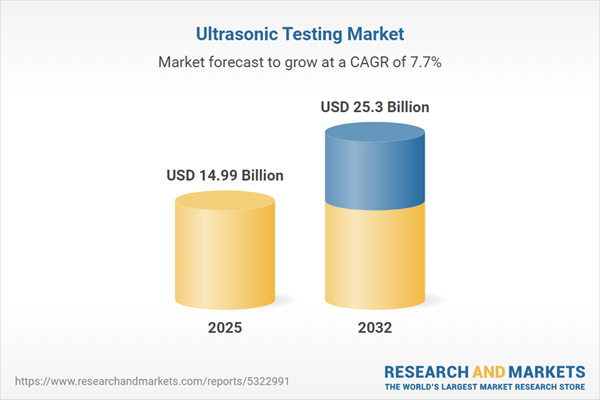Speak directly to the analyst to clarify any post sales queries you may have.
Senior decision-makers are navigating an increasingly complex operational environment, where stringent regulatory requirements and asset reliability expectations drive demand for robust inspection frameworks. The ultrasonic testing market serves as a cornerstone for organizations committed to managing risk and upholding continuous quality improvements.
Market Snapshot: Ultrasonic Testing Market Dynamics
The global ultrasonic testing market is forecasted for robust growth, with significant value gains projected between 2024 and 2025 and sustained expansion through 2032. This momentum is fuelled by widespread adoption of non-destructive testing across energy, aerospace, infrastructure, and manufacturing sectors where compliance and operational reliability are critical. Organizations are embedding ultrasonic inspection into their standard protocols to address heightened oversight and adjust to dynamic risk conditions. Both portable and benchtop ultrasonic systems play vital roles, enabling precise inspections within challenging environments. Continued technological advances drive efficiency, empowering enterprises to prevent costly failures and ensure asset longevity.
Scope & Segmentation: Strategic Factors for Senior Leaders
- Product Types: Benchtop and portable flaw detectors are essential for defect detection, reducing unplanned downtime and enhancing asset management in industries experiencing high operational demands.
- Precision Measurement Instruments: Advanced measurement tools deliver high accuracy and process compliance, directly supporting quality requirements in manufacturing and aerospace applications.
- Probes and Transducers: Contact, delay-line, shear-wave, and thickness gauges fulfill inspection needs spanning from energy sector infrastructures to critical medical devices.
- Technologies: Automated solutions, robotics, phased array, time-of-flight diffraction, contour-following, and immersion techniques extend defect detection capabilities for a variety of operational and advanced inspection applications.
- Deployment Modes: Fixed inline units enable real-time asset monitoring, while mobile and PC-integrated options facilitate inspections across remote or widely distributed facilities.
- End User Segments: Aerospace, defense, automotive, medical device manufacturing, metals and mining, semiconductors, oil and gas, and power generation organizations use ultrasonic testing for regulatory adherence and day-to-day reliability.
- Applications: Corrosion mapping, flaw analysis, material characterization, thickness assessment, and weld inspection help maintain asset performance and drive effective maintenance programs.
- Regional Coverage: Adoption and regulatory developments vary across the Americas, Europe, Middle East, Africa, and Asia-Pacific, influencing solution uptake and shaping regional market strategies.
- Company Profiles: Major providers—including Olympus Corporation, Baker Hughes Holdings LLC, MISTRAS Group, General Electric Company, Eddyfi Technologies, Zetec, Nikon Metrology, Sonatest, NDT Systems, and Applus Services—offer tailored expertise and localized support to address diverse industry requirements.
Key Takeaways for Senior Decision-Makers
- Phased array ultrasonic testing enhances detection accuracy and reduces risk across assets that comprise the core of critical infrastructure operations.
- Automated and robotic platforms support higher quality control standards by reducing variability and providing standardized best practices across a spectrum of industries.
- Versatile ultrasonic solutions aid organizations in meeting emerging quality benchmarks and in adapting to evolving global supply chain models and disruptions.
- Ongoing workforce training is necessary to leverage new inspection technologies and secure consistent, high-standard outcomes as global and regional standards advance.
- Strategic equipment maintenance and calibration partnerships drive process consistency and underpin long-term operational reliability.
- A broad and diverse supplier network increases resilience and responsiveness in fast-changing market landscapes.
Tariff Impact and Supply Chain Adaptation
Anticipated U.S. tariffs on imported ultrasonic testing equipment in 2025 have prompted organizations to review and modify supply chain approaches. Senior leaders are focusing on local sourcing, expanding supplier networks, and adjusting inventory management to minimize compliance risk and maintain consistent access to essential inspection technologies.
Methodology & Data Sources
This analysis combines cross-sector market research, technical benchmarks, and expert insights. All findings are peer reviewed and aligned with recognized industry protocols to deliver actionable intelligence for leaders in the ultrasonic testing market.
Why This Report Matters
- Equips leaders with actionable intelligence to optimize ultrasound inspection investments and ensure ongoing asset reliability amid regulatory shifts.
- Explains regulatory and supply chain impacts, enabling organizations to sustain inspection performance and mitigate operational risk.
- Offers guidance on integrating digital advancements to streamline compliance workflows and strengthen regional competitiveness.
Conclusion
By applying these insights, senior executives can better allocate resources, anticipate market and regulatory changes, and reinforce consistent operational excellence as ultrasonic testing evolves.
Additional Product Information:
- Purchase of this report includes 1 year online access with quarterly updates.
- This report can be updated on request. Please contact our Customer Experience team using the Ask a Question widget on our website.
Table of Contents
3. Executive Summary
4. Market Overview
7. Cumulative Impact of Artificial Intelligence 2025
Companies Mentioned
The companies profiled in this Ultrasonic Testing market report include:- Olympus Corporation
- Baker Hughes Holdings LLC
- MISTRAS Group, Inc.
- General Electric Company
- Eddyfi Technologies Inc.
- Zetec, Inc.
- Nikon Metrology NV
- Sonatest Limited
- NDT Systems, Inc.
- Applus Services, S.A.U.
Table Information
| Report Attribute | Details |
|---|---|
| No. of Pages | 180 |
| Published | October 2025 |
| Forecast Period | 2025 - 2032 |
| Estimated Market Value ( USD | $ 14.99 Billion |
| Forecasted Market Value ( USD | $ 25.3 Billion |
| Compound Annual Growth Rate | 7.7% |
| Regions Covered | Global |
| No. of Companies Mentioned | 11 |









